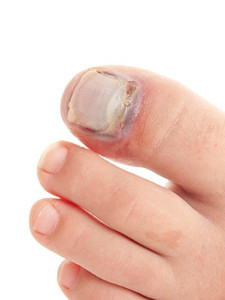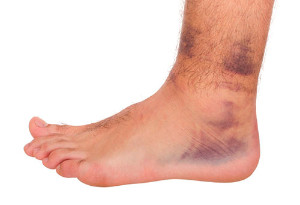Miami Shores (305) 631-2698

 The bones in the toes help to maintain stability and balance while walking. If the toe is stubbed or a heavy object is dropped on one of the toes, it may become broken. There are noticeable symptoms that appear when the toe is broken. These often include severe pain, swelling, and possible bruising. Additionally, many patients experience throbbing, and the toe may look red. Stress fractures are small breaks in the bones, and can be caused by frequently participating in running activities. This may gradually weaken the bones in the toes, and may cause a fracture. Mild relief may be found when the foot is elevated, and this can help in reducing any existing swelling. If you have broken your toe, it is suggested to seek counsel with a podiatrist who can suggest the best treatment for you.
The bones in the toes help to maintain stability and balance while walking. If the toe is stubbed or a heavy object is dropped on one of the toes, it may become broken. There are noticeable symptoms that appear when the toe is broken. These often include severe pain, swelling, and possible bruising. Additionally, many patients experience throbbing, and the toe may look red. Stress fractures are small breaks in the bones, and can be caused by frequently participating in running activities. This may gradually weaken the bones in the toes, and may cause a fracture. Mild relief may be found when the foot is elevated, and this can help in reducing any existing swelling. If you have broken your toe, it is suggested to seek counsel with a podiatrist who can suggest the best treatment for you.
Broken toes may cause a lot of pain and should be treated as soon as possible. If you have any concerns about your feet, contact Dr. Adam Auster from Florida. Our doctor will treat your foot and ankle needs.
What Is a Broken Toe?
A broken toe occurs when one or more of the toe bones of the foot are broken after an injury. Injuries such as stubbing your toe or dropping a heavy object on it may cause a toe fracture.
Symptoms of a Broken Toe
Although the injured toe should be monitored daily, it is especially important to have a podiatrist look at your toe if you have severe symptoms. Some of these symptoms include worsening or new pain that is not relieved with medication, sores, redness, or open wounds near the toe.
If you have any questions, please feel free to contact our offices located in Miami Shores and South Miami, FL. We offer the newest diagnostic and treatment technologies for all your foot care needs.
Read more about What to Know About a Broken Toe The medical condition that is referred to as flat feet occurs when the arch is missing from the foot. Most babies are born with flat feet, and the arch typically develops in the first few years of life. Some patients have flat feet as an adult, which can occur as a result of illness or injuries. Some of the symptoms that are associated with this condition include pain while standing for extended periods of time, in addition to an achy feeling in the ankles. Treatment of flat feet may begin with wearing orthotics in your shoes that can provide additional support. Pain and discomfort may be reduced when a healthy lifestyle is implemented. This can include losing excess weight, which may put pressure on the feet, in addition to performing a gentle exercise routine. If you have questions about flat feet, it is suggested that you speak to a podiatrist who can properly treat this condition.
The medical condition that is referred to as flat feet occurs when the arch is missing from the foot. Most babies are born with flat feet, and the arch typically develops in the first few years of life. Some patients have flat feet as an adult, which can occur as a result of illness or injuries. Some of the symptoms that are associated with this condition include pain while standing for extended periods of time, in addition to an achy feeling in the ankles. Treatment of flat feet may begin with wearing orthotics in your shoes that can provide additional support. Pain and discomfort may be reduced when a healthy lifestyle is implemented. This can include losing excess weight, which may put pressure on the feet, in addition to performing a gentle exercise routine. If you have questions about flat feet, it is suggested that you speak to a podiatrist who can properly treat this condition.
Flatfoot is a condition many people suffer from. If you have flat feet, contact Dr. Adam Auster from Florida. Our doctor will treat your foot and ankle needs.
What Are Flat Feet?
Flatfoot is a condition in which the arch of the foot is depressed and the sole of the foot is almost completely in contact with the ground. About 20-30% of the population generally has flat feet because their arches never formed during growth.
Conditions & Problems:
Having flat feet makes it difficult to run or walk because of the stress placed on the ankles.
Alignment – The general alignment of your legs can be disrupted, because the ankles move inward which can cause major discomfort.
Knees – If you have complications with your knees, flat feet can be a contributor to arthritis in that area.
Symptoms
Treatment
If you are experiencing pain and stress on the foot you may weaken the posterior tibial tendon, which runs around the inside of the ankle.
If you have any questions please feel free to contact our offices located in Miami Shores and South Miami, FL. We offer the newest diagnostic and treatment technologies for all your foot and ankle needs.
Read more about Flatfoot If ligaments in the ankle are torn or stretched, it is indicative of an ankle sprain. The purpose of these ligaments is to hold the ankle in place. If you have sprained your ankle, pain and discomfort is often experienced, and it may be difficult to bear any weight on the foot. Research has indicated there are two types of ankle sprains. These include eversion and inversion sprains. If the ankle turns in an outward direction, this is typically an eversion sprain. The latter occurs when the foot is twisted, and the ankle rolls inward. Some of the reasons why this type of injury occurs include wearing the wrong shoes, which can make it easier to fall, in addition to participating in high impact sporting activities. This produces stress on the ankle joints, which can lead to weakness in the foot. If you feel you have sprained your ankle, it is suggested to speak to a podiatrist who can perform a complete evaluation of the injured foot.
If ligaments in the ankle are torn or stretched, it is indicative of an ankle sprain. The purpose of these ligaments is to hold the ankle in place. If you have sprained your ankle, pain and discomfort is often experienced, and it may be difficult to bear any weight on the foot. Research has indicated there are two types of ankle sprains. These include eversion and inversion sprains. If the ankle turns in an outward direction, this is typically an eversion sprain. The latter occurs when the foot is twisted, and the ankle rolls inward. Some of the reasons why this type of injury occurs include wearing the wrong shoes, which can make it easier to fall, in addition to participating in high impact sporting activities. This produces stress on the ankle joints, which can lead to weakness in the foot. If you feel you have sprained your ankle, it is suggested to speak to a podiatrist who can perform a complete evaluation of the injured foot.
Ankle sprains are common but need immediate attention. If you need your feet checked, contact Dr. Adam Auster from Florida. Our doctor can provide the care you need to keep you pain-free and on your feet.
How Does an Ankle Sprain Occur?
Ankle sprains take place when the ligaments in your ankle are torn or stretched beyond their limits. There are multiple ways that the ankle can become injured, including twisting or rolling over onto your ankle, putting undue stress on it, or causing trauma to the ankle itself.
What Are the Symptoms?
Preventing a Sprain
Treatment of a Sprain
Treatment of a sprain depends on the severity. Many times, people are told to rest and remain off their feet completely, while others are given an air cast. If the sprain is very severe, surgery may be required.
If you have suffered an ankle sprain previously, you may want to consider additional support such as a brace and regular exercises to strengthen the ankle.
If you have any questions please feel free to contact our offices located in Miami Shores and South Miami, FL. We offer the newest diagnostic and treatment technologies for all your foot and ankle needs.
Read more about Ankle Sprains Some patients experience pain and discomfort at the bottom of the toes. This may be a result of a nerve that has become irritated and inflamed, and can be referred to as Morton’s neuroma. It develops as a result of wearing shoes that are too tight, which causes the toes to feel constricted. People who are overweight may develop this condition, in addition to ballet dancers who frequently wear pointed shoes. Mild relief may be found when the foot is massaged, in addition to wearing shoes that fit properly. There are several ways to treat severe cases of Morton’s neuroma, and it is suggested to consult with a podiatrist to explore treatment options that are correct for you.
Some patients experience pain and discomfort at the bottom of the toes. This may be a result of a nerve that has become irritated and inflamed, and can be referred to as Morton’s neuroma. It develops as a result of wearing shoes that are too tight, which causes the toes to feel constricted. People who are overweight may develop this condition, in addition to ballet dancers who frequently wear pointed shoes. Mild relief may be found when the foot is massaged, in addition to wearing shoes that fit properly. There are several ways to treat severe cases of Morton’s neuroma, and it is suggested to consult with a podiatrist to explore treatment options that are correct for you.
Morton’s neuroma is a very uncomfortable condition to live with. If you think you have Morton’s neuroma, contact Dr. Adam Auster of Florida. Our doctor will attend to all of your foot and ankle needs and answer any of your related questions.
Morton’s Neuroma
Morton's neuroma is a painful foot condition that commonly affects the areas between the second and third or third and fourth toe, although other areas of the foot are also susceptible. Morton’s neuroma is caused by an inflamed nerve in the foot that is being squeezed and aggravated by surrounding bones.
What Increases the Chances of Having Morton’s Neuroma?
Morton’s neuroma is a very treatable condition. Orthotics and shoe inserts can often be used to alleviate the pain on the forefront of the feet. In more severe cases, corticosteroids can also be prescribed. In order to figure out the best treatment for your neuroma, it’s recommended to seek the care of a podiatrist who can diagnose your condition and provide different treatment options.
If you have any questions, please feel free to contact our offices located in Miami Shores and South Miami, FL. We offer the newest diagnostic and treatment technologies for all your foot care needs.
Read more about What is Morton's Neuroma?